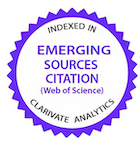O cultivo do milheto com água salobra e adubação orgânica altera as características do solo
DOI:
https://doi.org/10.1590/1809-6891v22e-70056Resumo
Regiões semiáridas são caracterizadas pela elevada evapotranspiração e baixa precipitação pluvial, favorecendo o acúmulo de sais quando irrigado com água salobra. Objetivou-se avaliar o efeito do cultivo de milheto com níveis de água salobra e fertilização orgânica nas propriedades químicas e físicas do solo. Adotou-se o delineamento de blocos ao acaso, com arranjo fatorial, em parcelas subdivididas, com três repetições. As parcelas foram constituídas por quatro lâminas de irrigação (25, 50, 75 e 100% da evapotranspiração da cultura) e as subparcelas foram compostas por quatro níveis de fertilização orgânica (0; 15; 30 e 45 Mg ha-1). No final do ciclo de produção do milheto, o solo foi coletado nas camadas de 0-0,20 e 0,20-0,40 m, para aspectos físicos (densidade do solo, densidade de partículas e porosidade) e químicos (CE, pH, K, Na, Ca, Mg, H + Al, SB, CTC, V). Não houve interação entre a água salobra e a fertilização orgânica nas propriedades químicas do solo. A água salobra reduziu o potássio na camada de 0,20-0,40 m. Observou-se efeito linear negativo para densidade na camada 0,20 - 0,40 m sob níveis de fertilização orgânica. Níveis de água salobra e fertilizante orgânico no cultivo do milheto não altera as propriedades químicas e físicas do solo na camada de 0-0,20 m. Porém, o uso de água salobra reduz a concentração de potássio no solo e a aplicação de fertilização orgânica reduz a densidade do solo na camada de 0,20-0,40 m.
Palavras-chave: Agricultura biossalina; Pennisetum glaucum (L.) R. Br; Saturação por bases
Downloads
Referências
Magalhães ALR, Sousa DR, Nascimento Júnior JRS, Gois GC, Campos FS, Santos KC, Nascimento DB, Oliveira LP. Intake, digestibility and rumen parameters in sheep fed with common bean residue and cactus pear. Biol. Rhyt. Res. 2019; 52(1):1-10. Disponível em: https://doi.org/10.1080/09291016.2019.1592351.
Silva FJBC, Azevedo JRG. Temporal trend of drought and aridity indices in semi-arid pernambucano to determine susceptibility to desertification. Braz. J. Water Res. 2020; 25(e32):1-18. Disponível em: https://doi.org/10.1590/2318-0331.252020190145.
Cavalcante ES, Lacerda CF, Costa RNT, Gheyi HR, Pinho LL, Bezerra FMS, Oliveira AC, Canjá JF. Supplemental irrigation using brackish water on maize in tropical semi-arid regions of Brazil: yield and economic analysis Sci. Agric. 2021; 78(e20200151):1–9. Disponível em: https://doi.org/10.1590/1678-992X-2020-0151.
Silva AJ, Aguiar Netto AO, Lucas AAT, Araújo RR, Sousa AF. Reduction of salinity and sodicity of saline-sodic soils under filed condition in Brazilian semi-arid region. Scient. Plena. 2020; 16(9):1-14. Disponível em: https://doi.org/10.14808/sci.plena.2020.090203.
Haj‑Amor Z, Hashemi H, Bouri S. The consequences of saline irrigation treatments on soil physicochemical characteristics. Euro-Med. J. Env. Int. 2018; 3(22):1-12. Disponível em: https://doi.org/10.1007/s41207-018-0064-y.
Tedeschi A. Irrigated agriculture on saline soils: A perspective. Agron. 2020; 10(11):1-6. Disponível em: https://doi.org/10.3390/agronomy10111630.
Acosta-Motos JR, Ortuño MF, Bernal-Vicente A, Diaz-Vivancos P, Sanchez-Blanco MJ, Hernandez JA. Plant responses to salt stress: Adaptive mechanisms. Agron. 2017; 7(1):1-38, 2017. Disponível em: https://doi.org/10.3390/agronomy7010018.
Arora S, Singh AK, Singh YP. Bioremediation of salt affected soils: An Indian perspective, 1st ed. Switzerland: Springer Nature; 2017. 313p.
Adeleke R, Nwangburuka C, Oboirien B. Origins, roles and fate of organic acids in soils: A review. South Afr. J. Bot. 2017; 108(1):393-406. Disponível em: https://doi.org/10.1016/j.sajb.2016.09.002.
Souza MCMR, Menezes A, Costa RS, Amorim AV, Lacerda CF. Tolerância à salinidade e qualidade de mudas de noni sob diferentes ambientes e matéria orgânica. Rev. Bras. Agric. Irrig. 2017a; 11(7):2052-2062. Disponível em: https://doi.org/10.7127/rbai.v11n700682.
Leal YH, Dias TJ, Bezerra AC, Leal MPS, Lopes AS, Moura JG, Ribeiro JES, Souza AG. Application times and doses of bovine and sheep biofertilizers in the morphophysiological characteristics of green pepper plants. Scientia Plena, VOL. 16, NUM. 9, 1-10. 2020. Disponível em: https://doi.org/10.14808/sci.plena.2020.090202.
Zhang Z, Zhang Z, Lu P, Feng G, Qi W. Soil water-salt dynamics and maize growth as affected by cutting length of topsoil incorporation straw under brackish water irrigation. Agron. 2020; 10(2):1-17. Disponível em: https://doi.org/10.3390/agronomy10020246.
Silva AJ, Aguiar Netto AO, Lucas AAT, Araújo RR, Sousa AF. Reduction of salinity and sodicity of saline-sodic soils under filed condition in Brazilian semi-arid region. Sci. Plena. 2020; 16(9):1-14. Disponível em: https://doi.org/10.14808/sci.plena.2020.090203
Souza LP, Lima GS, Gheyi HR, Nobre RG, Soares LAA. Emergence, growth, and production of colored cotton subjected to salt stress and organic fertilization. Rev. Caat. 2018; 31(3): 719–729. Disponível em: https://doi.org/10.1590/1983-21252018v31n322rc.
Souza LP, Nobre RG, Barbosa JL, Lima GS, Almeida LLS, Pinheiro FW. Cultivo do algodoeiro cv. BRS Topázio em solos salino-sódico com adição de matéria orgânica. Rev. Espacios. 2017b; 38(14):1-12. Disponível em: https://www.revistaespacios.com/a17v38n14/a17v38n14p18.pdf.
Lira JB, Andrade AP, Magalhães ALR, Campos FS, Araújo GGL, Deon DS, Gois GC, Regitano Neto A, Cunha DS, Tabosa JN, Silva TGF, Nagahama HJ. Production of Pearl millet irrigated with different levels of saline water and organic matter. Commun. Soil Sci. Plant An. 2020; 51(5):701-709. Disponível em: https://doi.org/10.1080/00103624.2020.1729794.
Moura MMA, Pires DAA, Jayme DG, Costa RF, Rigueira JPS, Rodrigues JAS. Agronomic performance and nutritive value of millet silages. Acta Scient. An. Sci. 2018; 40(e34430):1-6. Disponível em: https://doi.org/10.4025/actascianimsci.v40i1.34430.
Iwuala EN, Odjegba VJ, Sharma V, Alam A. Highlights of strategies adapted by two Pennisetum glaucum (L.) R. Br. races in a simulated drought stress experiment. Plant Gen. 2020; 23(1):1-34. Disponível em: https://doi.org/10.1016/j.plgene.2020.100238.
Cosgrove WJ, Loucks DP. Water management: current and future challenges and research directions. Water Resour. Res. 2015; 51(6):4823–4839. Disponível em: https://doi.org/10.1002/2014WR016869.
Makarana G, Kumar A, Yadav RK, Kumar R, Soni PG, Lata C, Sheoran P. Effect of saline water irrigations on physiological, biochemical and yield attributes of dual purpose pearl millet (Pennisetum glaucum) varieties. Indian J. Agric. Sci. 2019; 89(4):624-633. Disponível em: https://www.researchgate.net/publication/330041855_Effect_of_saline_water_irrigations_on_physiological_biochemical_and_yield_attributes_of_dual_purpose_pearl_millet_Pennisetum_glaucum_L_varieties.
Köppen W, Geiger RG. Klimate der Erde. Gotha: Verlag Justus Perthes, Wall-map 150 cm × 200 cm. 1928.
Santos HG, Jacomine PKT, Anjos LHC, Oliveira VA, Lumbreras JF, Coelho MR, Almeida JA, Araújo Filho JC, Oliveira JB, Cunha TJF. Sistema brasileiro de classificação de solos, 5th ed. Brasília: Embrapa; 2018. 356p. Disponível em: https://www.embrapa.br/solos/sibcs.
Allen RG, Pereira LS, Raes D, Smith M. Crop evapotranspiration: Guidelines for computing crop water requirements. Roma, 56, Food and Agriculture Organization, Drainage and Irrigation Paper; 1998. 300p. Disponível em: http://www.fao.org/3/x0490e/x0490e00.htm.
Lima JGA. Necessidades hídricas do Sorgo de pura aptidão sob condições irrigadas na chapada do Apodi. [dissertação]. Mossoró: Universidade Federal Rural do Semi-Árido; 2013. 74 p.
Richards LA. Diagnosis and improvement of saline and alkali soils, 1st ed. Washington D.C.: Agriculture Handbook; 1954. 166p.
Montovani EC, Bernardo S, Palaretti LF. Irrigação - princípios e métodos, 1st ed. Viçosa: Editora UFV; 2006. 318p.
Aoac. Association of Official Analytical Chemists. Official methods of analysis, 20th ed. Washington, D.C.: Latimer Jr., G.W.; 2016. 3172p.
Holanda Filho RSF, Santos DB, Azevedo CAV, Coelho EF, Lima VLA. Água salina nos atributos químicos do solo e no estado nutricional da mandioqueira. Rev. Bras. Eng. Agric. Amb. 2011; 15(1):60-66. Disponível em: https://doi.org/10.1590/S1415-43662011000100009.
Coldebella N, Lorenzetti E, Tartaro J, Treib EL, Pinto RE, Fontana A, Alves AB. Desempenho do milho à elevação da participação do cálcio na CTC. Scient. Agr. Paranaensis. 2018; 17(4):443-450. Disponível em: http://e-revista.unioeste.br/index.php/scientiaagraria/article/view/20230.
Claessen MEC. Manual de métodos de análise de solo, 2nd ed. Rio de Janeiro: Embrapa-CNPS; 1997. 212p.
Tränkner M, Tavakol E, Jákli B. Functioning of potassium and magnesium in photosynthesis, photosynthate translocation and photoprotection. Phy. Plant. 2018; 163(3):414-431. Disponível em: https://doi.org/10.1111/ppl.12747.
Hasanuzzaman M, Bhuyan MHMB, Nahar K, Hossain MS, Al Mahmud J, Hossen MS, Masud AAC, Moumita, Fujita M. Potassium: A vital regulator of plant responses and tolerance to abiotic stresses. Agron. 2018; 8(3):1-29. Disponível em: https://doi.org/10.3390/agronomy8030031.
Munir A, Nawaz S, Bajwa MA. Farm manure improved soil fertility in mungbean-wheat cropping system and rectified the deleterious effects of brackish water. Pak. J. Agric. Sci. 2012; 49(4):511-519.
Li J, Awasthi MK, Xing W, Liu R, Bao H, Wang X, Wu F. Arbuscular mycorrhizal fungi increase the bioavailability and wheat (Triticum aestivum L.) uptake of selenium in soil. Ind. Crops Prod. 2020; 150(e112383):1-9. Disponível em: https://doi.org/10.1016/j.indcrop.2020.112383.
Yan S, Gao Y, Tian M, Tian Y, Li J. Comprehensive evaluation of effects of various carbon-rich amendments on tomato production under continuous saline water irrigation: Overall soil quality, plant nutrient uptake, crop yields and fruit quality. Agric. Water Man. 2021; 255(e106995): 1-12. Disponível em: https://doi.org/10.1016/j.agwat.2021.106995.
Husniev I, Romanenkov V, Minakova O, Krasilnikov P. Modelling and prediction of organic carbon dynamics in arable soils based on a 62-year field experiment in the Voronezh region, European Russia. Agron. 2020; 10(10):1-16. Disponível em: https://doi.org/10.3390/agronomy10101607.
Mayer M, Prescott CE, Abaker WEA, Augusto L, Cécillon L, Ferreira GWD, James J, Jandl R, Katzensteiner K, Laclau JP, Laganière J, Nouvellon Y, Paré D, Stanturf JA, Vanguelova EI, Vesterdal L. Tamm Review: Influence of forest management activities on soil organic carbon stocks: A knowledge synthesis. Forest Ecol. Manag. 2020; 466(e118127):1-25, 2020. Disponível em: https://doi.org/10.1016/j.foreco.2020.118127.
Xia LI, He KL, Wang ZY, Bai SX. Quantitative trait loci for Asian Corn Borer resistance in maize population Mc37× Zi330. Agric. Sci. China. 2010; 9(1):77-84. Disponível em: https://doi.org/10.1016/S1671-2927(09)60070-5.
Chachar AN, Mirjat MU, Soothar RK, Shaikh IA, Mirjat MH, Dahri SA. Effects of irrigation frequencies on soil salinity and crop water productivity of fodder maize. Acta Ecol. Sinica. 2020; 40(4):277-282. Disponível em: https://doi.org/10.1016/j.chnaes.2019.05.013.
Sahab S, Suhani I, Srivastava V, Chauhan PS, Singh RP, Prasad V. Potential risk assessment of soil salinity to agroecosystem sustainability: current status and management strategies. Sci. Total Env. 2021; 764(e144164):1-69. Disponível em: https://doi.org/10.1016/j.scitotenv.2020.144164.
Otlewska A, Migliore M, Dybka-Stepien K, Manfredini A, Struszczyk-Swita K, Napoli R, Białkowska A, Canfora L, Pinzari F. When salt meddles between plant,soil, and microorganisms. Front. Plant Sci. 2020; 11(e553087):1-23. Disponível em: https://doi.org/10.3389/fpls.2020.553087.
Rezaei M, Seuntjens P, Shahidi R, Joris I, Boënne W, Al-Barri B, Cornelis W. The relevance of in-situ and laboratory characterization of sandy soil hydraulic properties for soil water simulations. J. Hydro. 2016; 534(1):251-265. Disponível em: https://doi.org/10.1016/j.jhydrol.2015.12.062.
Dias AS, Nobre RG, Lima GD, Gheyi HR, Pinheiro FWA. Crescimento e produção de algodoeiro de fibra colorida cultivado em solo salino-sódico e adubação orgânica. Irriga. 2016; 1(1):260-273. Disponível em: https://doi.org/10.15809/irriga.2016v1n1p260-273.
Braida JA, Bayer C, Albuquerque JA, Reichert JM. Matéria orgânica e seu efeito na física do solo. In: Klauberg Filho O, Mafra Al, Gatiboni LC, editores. Tópicos em ciência do solo, 7th ed. Viçosa, MG: Sociedade Brasileira de Ciência do Solo; 2011. p.221-278. Disponível em: https://www.researchgate.net/publication/283498634_Materia_organica_e_seu_efeito_na_fisica_do_solo.
Carmo DL, Lima LB, Silva CA. Soil fertility and electrical conductivity affected by organic waste rates and nutrient inputs. Rev. Bras. Ci. Solo. 2016; 40(e0150152): 1-17. Disponível em: https://doi.org/10.1590/18069657rbcs20150152.
Zagatto MRG, Zanão Júnior LA, Pereira APA, Estrada-Bonilla G, Cardoso EJBN. Soil mesofauna in consolidated land use systems: how management affects soil and litter. Sci. Agric. 2019; 76(2): 165-171. Disponível em: http://dx.doi.org/10.1590/1678-992X-2017-0139.
Haanes H, Gjelsvik R. Reduced soil fauna decomposition in a high background radiation área. PLoS One. 16(3): e0247793. Disponível em: https://doi.org/10.1371/journal.pone.0247793.
Bottinelli N, Jouquet P, Capowiez Y, Podwojewski P, Grimaldi M, Peng X. Why is the influence of soil macrofauna on soil structure only considered by soil ecologists? Soil Til. Res. 2015; 146(3):118-124. Disponível em: https://doi.org/10.1016/j.still.2014.01.007.
Calonego JC, Raphael JPA, Rigon JPG, Oliveira Neto L, Rosolem CA. Soil compaction management and soybean yields with cover crops under no-till and occasional chiseling. Eur. J. Agron. 2017; 85(1):31–37. Disponível em: https://doi.org/10.1016/j.eja.2017.02.001.
Downloads
Publicado
Como Citar
Edição
Seção
Licença
Copyright (c) 2021 Ciência Animal Brasileira

Este trabalho está licenciado sob uma licença Creative Commons Attribution 4.0 International License.
Autores que publicam nesta revista concordam com os seguintes termos:
- Autores mantém os direitos autorais e concedem à revista o direito de primeira publicação, com o trabalho simultaneamente licenciado sob a Licença Creative Commons Attribution que permite o compartilhamento do trabalho com reconhecimento da autoria e publicação inicial nesta revista.
- Autores têm autorização para assumir contratos adicionais separadamente, para distribuição não-exclusiva da versão do trabalho publicada nesta revista (ex.: publicar em repositório institucional ou como capítulo de livro), com reconhecimento de autoria e publicação inicial nesta revista.
- Autores têm permissão e são estimulados a publicar e distribuir seu trabalho online (ex.: em repositórios institucionais ou na sua página pessoal) a qualquer ponto antes ou durante o processo editorial, já que isso pode gerar alterações produtivas, bem como aumentar o impacto e a citação do trabalho publicado (Veja O Efeito do Acesso Livre).






























